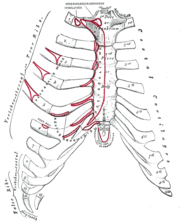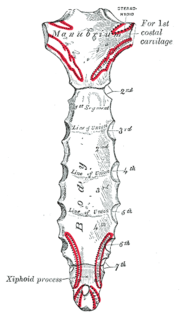- Xiphoid
-
Das Brustbein oder lat. Sternum ist ein platter, schwertförmiger Knochen in der vorderen Mitte des Brustkorbs, an dem die Rippen bzw. deren knorpelige Verlängerungen ansetzen. Für hinter dem Brustbein gelegene Strukturen verwendet man die Lagebezeichnung retrosternal, für seitlich des Brustbeins gelegene parasternal.
Seinen lateinischen Namen erhielt es, weil es einem Schwert der Antike (Sternum) ähnlich sieht. Dementsprechend werden die einzelnen Teile des Knochens auch benannt als:
- Manubrium sterni (Handgriff)
- Corpus sterni (Körper)
- Processus xiphoideus (Schwertfortsatz)
Am kopfnahen (kranialen) oberen Ende des Manubriums ist eine Einkerbung, die Incisura jugularis (von lat. jugulum „kleines Joch“), gut tastbar und markiert das untere Ende des Halses, die Drosselgrube. Zu beiden Seiten dieser Einkerbung befinden sich Gelenkflächen, die der Verbindung mit den Schlüsselbeinen im Sternoklavikulargelenk dienen. Knapp unterhalb dieser Gelenkflächen markiert jeweils die Incisura costalis prima den Ort der knorpeligen Verbindung mit der ersten Rippe.
Die zweite Rippe setzt beidseits im Winkel zwischen dem Handgriff und dem Körper des Brustbeins (Angulus sterni oder Ludovici), die Rippen 3 bis 7 an Einkerbungen des Brustbeinkörpers an.
Das Brustbein des Mannes ist schlanker als das der Frau.
Processus xiphoideus
Der Processus xiphoideus (das Xiphoid oder Schwertfortsatz, manchmal auch Schwertknorpel) stellt das knöchern-knorpelige untere Ende des Brustbeins dar. Manchmal ist es mit diesem über eine Knorpelbrücke (Synchondrosis xiphosternalis) verbunden.
Das Xiphoid ist von unterschiedlicher Form: Es kann als kompaktes oder zweistrahliges Gebilde ausgebildet sowie nach vorne oder hinten abgebogen sein. Am Xiphoid setzen keine Rippen mehr an. Der Einschnitt für die letzte noch direkt am Sternum ansetzende, siebte Rippe findet sich am Körper des Brustbeins direkt vor dem Übergang zum Xiphoid.
Im knorpelig vorgebildeten Xiphoid können im 5. bis 10. Lebensjahr ein bis zwei Knochenkerne auftreten.
Literatur
- Walther Graumann, Dieter Sasse: Compactlehrbuch Anatomie. Schattauer Verlag 2003, ISBN 3-7945-2062-9, S.47ff (eingeschränkte Online-BVersion (Google Books))
Wikimedia Foundation.



